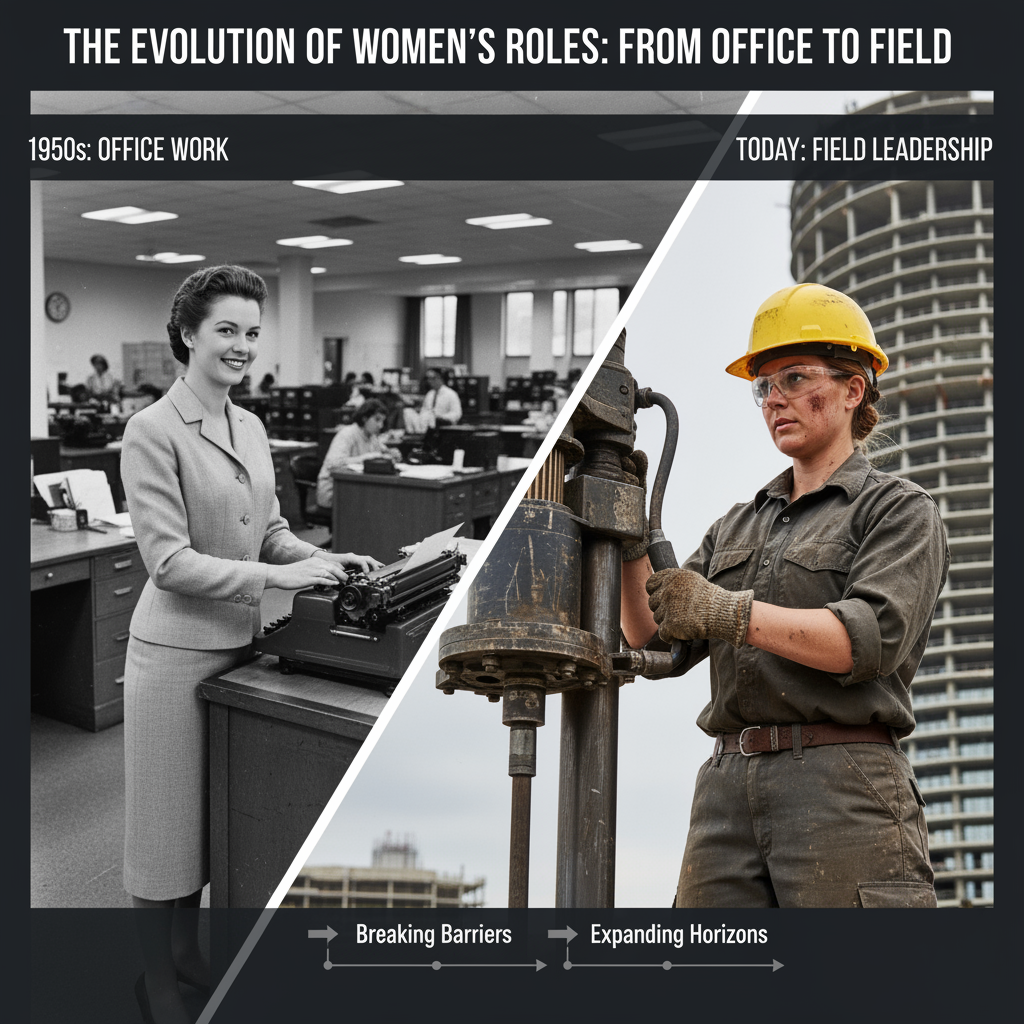Women in Construction
Breaking Barriers and Building Success with HKC Construction
The construction industry stands at a pivotal moment in 2025 as women reach 11.5% of the construction workforce, marking significant progress in an historically male-dominated field. Women now represent 14% of the construction workforce up from 10.9% just five years ago, demonstrating accelerated growth that signals fundamental industry transformation. Companies like HKC Construction are leading this change, proving that women-owned construction businesses can thrive while fostering inclusive workplaces that benefit everyone.Women Building the Future
The landscape for women in construction jobs has evolved dramatically. The share of women in construction has steadily increased over the past several years, marking progress in diversifying the industry. While women remain underrepresented in the workforce, the data reveals a gradual yet consistent upward trend in female employment within the construction sector. Prior to 2016, women comprised approximately 9% of the construction workforce. This figure held relatively steady for over a decade, fluctuating slightly between 8.9% and 9.5% from 2003 to 2015. However, since 2016, the share of female employees in construction has climbed nearly every year, reaching 11.1% in 2022 and continuing to rise to 11.5% by 2023.
Regional Leadership in Female Construction Employment
Geographic variations reveal promising trends for professional women in construction. Alaska and Hawaii lead the nation in female construction employment, with women making up 13.8% and 13.4% of the industry's workforce, respectively. These states likely benefit from the relatively high wages offered in the construction sector, which can be an attractive factor for women entering the field. States in the Pacific Northwest, such as Washington (12.7%) and Oregon (12.5%), and parts of the South Atlantic, including Florida (13.3%) and Maryland (12.4%), also report female representation above the national average of 11.5%.
Metropolitan areas show even stronger representation. Metros like Jacksonville, FL (17.4%), Orlando, FL (16.1%), and New Orleans, LA (14.4%) rank among the top metros for female construction employment. These statistics demonstrate that targeted regional efforts can successfully increase female participation in construction careers.
The Evolution of Women's Roles: From Office to Field
While progress continues, disparities persist in role distribution. Women are far more likely to work in office and administrative positions, while men dominate field-based roles. According to the Bureau of Labor Statistics, women make up nearly 80% of the construction industry's office and administrative roles. They also are more highly concentrated in professional, sales, and management roles compared to other occupations in the sector.
However, encouraging shifts are emerging in skilled trades. Careers such as electricians, welders, carpenters, and heavy equipment operators have seen a 7% rise in female participation since 2020, thanks to targeted apprenticeship programs and outreach efforts. This trend indicates growing opportunities for women in construction statistics to improve across all job categories.
Breaking Through Barriers: Challenges and Solutions
Workplace Culture and Discrimination
The construction industry's traditionally masculine culture creates significant obstacles. Research indicates that workplace harassment remains a critical issue, with many women reporting discrimination and unfair treatment that impacts retention rates. Companies implementing zero-tolerance policies and comprehensive diversity training are seeing improved outcomes in employee satisfaction and retention.
Work Life Balance in Construction
50% of female construction workers had children younger than eighteen, while 21.9% had children younger than six. This statistic highlights the importance of family-friendly policies in attracting and retaining female talent. Progressive companies are implementing flexible scheduling, on-site childcare options, and paid family leave to address these challenges.
Safety Equipment and Facilities
The lack of properly fitting personal protective equipment (PPE) designed for women's body types remains a significant safety concern. Additionally, inadequate facilities, including insufficient restrooms on job sites, create practical barriers to women's participation in field roles. Industry leaders are partnering with manufacturers to develop appropriate safety gear and updating site facilities to accommodate all workers.
HKC Construction: A Blueprint for Success
HKC Construction exemplifies how women owned construction companies can lead industry transformation. Founded in 2010 by Helen and Kosta Mentis, the company has achieved remarkable growth while maintaining a commitment to diversity and inclusion that sets new industry standards.
Leadership Excellence
As Executive Vice President, Helen Mentis brings extensive experience in education, real estate, and construction management to her role. The company's success is evident in its recognition as the 5th fastest-growing women-led company in Canada, with a 1,186% revenue increase over three years. This achievement demonstrates that women's leadership in construction drives both innovation and profitability.
Diversity as Competitive Advantage
HKC Construction's workforce composition challenges industry norms:
45% female employees across all roles
29% visible minority representation
50% immigrant workforce
Merit-based hiring prioritizing qualifications
The company's recognition as a Best Place to Work in 2024 validates their inclusive approach. Their success proves that diversity initiatives enhance rather than compromise business performance.
Industry Advocacy and Education
HKC Construction actively promotes national women in construction week and year-round advocacy through:
Educational content and resources during Women in Construction Week
Mentorship programs for emerging professionals
Public speaking engagements on diversity and innovation
Partnerships with organizations promoting women in trades
Economic Impact: The Business Case for Gender Diversity
Performance Metrics
Teams with a mix of genders are 25% more likely to outperform their peers in innovation and output. Research shows that construction companies with higher female representation report a 25% increase in project efficiency and improved safety records. These statistics demonstrate clear competitive advantages for companies embracing gender diversity.
Addressing Labor Shortages
With the construction industry facing a massive worker shortage estimated to exceed half a million workers recruiting women into construction roles has become not just a priority, but a necessity for sustaining growth and meeting demand. Women represent an essential talent pool for addressing industry workforce challenges.
Technology and Innovation: Women Leading Digital Transformation
Women in construction 2025 are increasingly associated with technological advancement. Female professionals are leading adoption of:
Building Information Modeling (BIM) systems
Project management software implementation
Sustainable construction practices
Safety technology innovations
Digital collaboration tools
This technological leadership positions women as key drivers of construction industry modernization.
Building Tomorrow: Future Opportunities
Education and Training Initiatives
In 2025, women hold over 20% of leadership positions in construction companies, a notable improvement driven by initiatives like NAWIC's mentorship programs and company-sponsored diversity efforts. Women are also making inroads into skilled trades once considered off-limits.
Key educational developments include:
NAWIC Founders' Scholarship Foundation programs
Women's Apprenticeship and Nontraditional Occupations (WANTO) grants
University partnerships for construction management programs
Pre-apprenticeship programs targeting young women
Technical skills training in emerging construction technologies
Mentorship and Networking
Professional organizations are expanding support systems:
NAWIC's 6,000+ members across 120+ chapters
Women in Construction Hub resources
Regional networking events and conferences
Online communities and virtual mentorship programs
Cross-industry partnerships promoting best practices
HKC Construction's Ongoing Commitment
HKC Construction continues expanding its impact through strategic initiatives:
Internal Development Programs
Leadership training for female employees
Skills development workshops
Career advancement pathways
Continuing education support
Performance-based promotion systems
External Partnerships
Collaborations with educational institutions
Supplier diversity programs
Community outreach initiatives
Industry association leadership roles
Public-private partnership participation
Innovation Focus
The company leverages diverse perspectives to drive innovation in:
Sustainable building practices
Safety protocol development
Project management methodologies
Client relationship strategies
Technology integration
Industry Transformation: Collective Progress
Policy and Advocacy
Legislative and policy developments supporting women in construction include:
Equal Employment Opportunity Commission enforcement
Government contracting preferences for women-owned businesses
Funding for diversity initiatives
Workplace safety regulations addressing gender-specific needs
Anti-discrimination legislation strengthening
Cultural Shifts
The construction industry culture is evolving through:
Increased visibility of female role models
Media representation improvements
Educational outreach to young women
Family-friendly workplace policies
Zero-tolerance harassment enforcement
Measuring Success: Key Performance Indicators
Organizations tracking progress use metrics including:
Female workforce percentage by role category
Leadership representation rates
Retention and advancement statistics
Pay equity measurements
Safety incident rates by gender
Training program participation
Mentorship program outcomes
Looking Ahead: Construction's Inclusive Future
The trajectory for women in construction careers points toward continued growth. Industry projections suggest women could reach 20% of the construction workforce by 2030, driven by:
Ongoing labor shortage pressures
Generational attitude shifts
Technology reducing physical barriers
Proven business case for diversity
Strengthened support systems
Building The Future Together
The construction industry's transformation through increased female participation represents more than statistical progress it signals fundamental cultural and operational evolution. HKC Construction's success story demonstrates that women-owned and women-led construction companies can compete at the highest levels while creating inclusive environments benefiting all workers.
As the industry confronts labor shortages, technological disruption, and evolving client expectations, women's contributions become increasingly vital. Companies like HKC Construction prove that embracing diversity isn't just socially responsible it's strategically essential for business success.
The path forward requires continued commitment from industry leaders, educational institutions, policymakers, and individual companies. By following the blueprint established by pioneers like HKC Construction combining merit-based hiring, comprehensive support systems, and genuine cultural change the construction industry can build a more inclusive, innovative, and prosperous future.
For women considering construction careers, the message is clear: opportunities exist, support systems are strengthening, and success stories like HKC Construction illuminate the path forward. The industry needs diverse talent, perspectives, and leadership to meet tomorrow's challenges. Together, we're not just building structures we're building a more equitable and successful construction industry for all.










